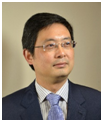报告题目:Advanced electrode materials for energy storage andconversion
报告人:Prof.Guoxiu Wang
时间:2019年3月26日上午10:00
地点:浙江大学玉泉校区曹光彪大楼324会议室
邀请人:韩伟强教授
Abstract:
Materials architecture designis required for thedevelopment of advanced energy storageand conversion.Porous graphene exhibited significantly higher discharge capacities than that of non-porous graphene. The Ru nanocrystal decorated porous graphene exhibited an excellent catalytic activity with a high reversible capacity, low charge/dischargeover-potential, and long cycle life [1, 2]. Ionic liquid bearing the redox active 2,2,6,6-tetramethyl-1-piperidinyloxy moiety serves multiple functions as redox mediator, oxygen shuttle, lithium anode protector, as well as electrolyte solvent. The additive contributes a 33-fold increase of the discharge capacity in comparison to a pure ether-based electrolyte and lowers the over potential to an exceptionally low value of 0.9 V. Besides, it enables an outstanding electrochemical performance when operated in air [3]. Furthermore, sodium-air batteries were also investigated [4].Several electrode materials were synthesized as either cathode materials or anode materials for sodium-ion batteries, potassium-ion batteries and sodium-sulfur batteries [5 - 7].
Single-atom catalystsoffer a pathway to cost-efficient catalysis with the minimal amount of precious metal used. Double transition-metal Mxene (Mo2TiC2Tx) nanosheets were syntheised, with abundant exposed basal planes and Mo vacancies in the outer layers by electrochemical exfoliation.The developed catalyst exhibits an outstanding catalytic ability with a low overpotential and a mass activity about 40 times greater than the commercial platinum-on-carbon catalyst. [8]
References:
[1] B. Sun, G. Wang et al., Nano Lett., 2014, 14, 3145.
[2] J. Zhang, G. Wang et al., Angew. Chem. Int. Ed., 2017, 56, 8505.
[3] J. Zhang, G. Wang et al., Nat. Commun., 2019, DOI.org/10.1038/341467-019-08422-8.
[4] B. Sun, G.Wang et al., Adv. Mater. 2017, 29, 1606816.
[5] D. Su, G. Wang et al, Adv, Mate,, 2017, 29, 1604007.
[6] D. Zhou, G. Wang et al., Angew. Chem. Inter. Ed., 2018, 57, 10168.
[7] X. Xu, D. Zhou, B. Li, G. Wang et al., Nat. Commun. 2018, 9, 3870.
[8] J. Zhang, G. Wang, et al., Nat. Catalysis 2018, 1, 985.
Biography:
Prof. Guoxiu Wang is the Director of the Centre for Clean Energy Technology and a Distinguished Professor at University of Technology Sydney (UTS), Australia. He is an expert in materials chemistry, electrochemistry, energy storage and conversion, and battery technologies. Currently, he serves as a regional editor for Polyhedron, an Associate Editor for Frontiers in Energy Research, an editorial board member for Scientific Reports (Nature Publishing Group) and Energy Storage Materials (Elsevier). Prof.Wang is a member of the Australian Research Council (ARC) College of Experts. His research interests include lithium-ion batteries, lithium-air batteries, sodium-ion batteries, lithium-sulfur batteries, supercapacitors, hydrogen storage materials, fuel-cells, 2D materials such as graphene and MXene, and electrocatalysis for hydrogen production. He has published more than 460 refereed journal papers with an h-index of 94. His publications have attracted over 30,000 citations. Prof.Wang has been listed as a Highly Cited Research in both categories of Materials Science and Chemistry in 2018 by Web of Science/Clarivate Analytics

